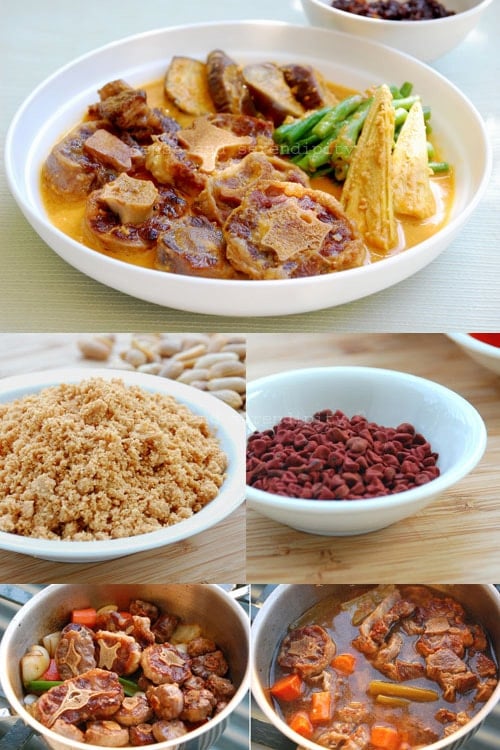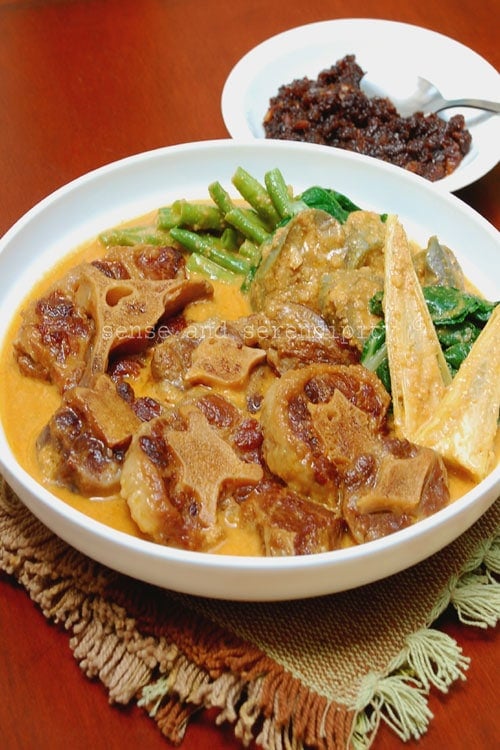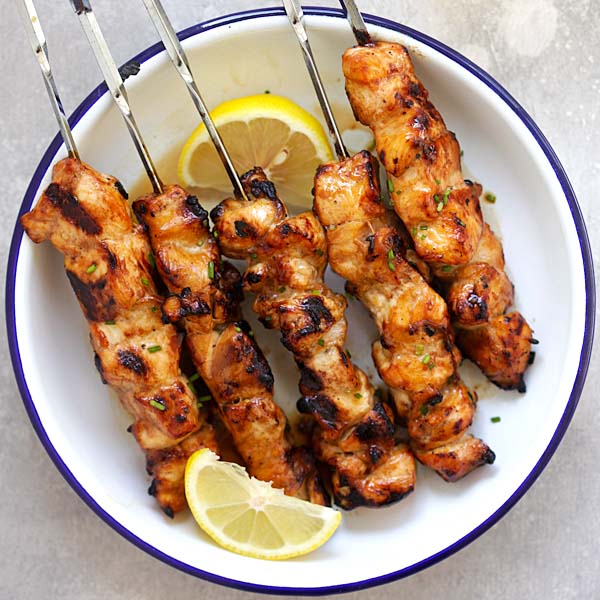This post may contain affiliate links. Please read my privacy policy.
Kare Kare (Filipino Oxtail Stew) - this delicious stew is made in the Philippines using a savory peanut sauce, oxtail, and vegetables. Try it at home today.

What Is Kare Kare
Kare kare is a delicious oxtail stew made with peanut sauce that originates from the Philippines. This delicious and hearty stew is a must when it comes to the colder months, and reminds people of home.
This oxtail stew is a great recipe and is simple enough for you to make at home today.
Another Filipino dish you need to try is shrimp sinigang and Lumpia.
Main Ingredients For Kare Kare Recipe
- Oxtail
- Beef ribs
- Onions
- Carrots
- Celery
- Peanuts
- Eggplant
- Calamansi
- Fermented shrimp paste
- Shallots
- Jasmine rice
See the recipe card for full information on ingredients.
Cooking Tips

- I always cook the meat one day ahead, store in the fridge and remove the hardened fat on the surface the following day.
- The meat is usually ox tail but it can also be done with other cuts of beef such as beef shanks or short ribs, or a combination of both. Sometimes tripe is also added.
- The sauce is made of sliced onions, finely ground peanuts, toasted ground rice and the annatto seeds (mainly for color).
- This is a dish that you could either hate or love because of its naturally bland flavor and the type of peanuts or even peanut butter that you use would make a huge difference.
- While beef is the most common ingredient, Kare Kare can also be made with seafood (prawns, squid, and mussels) or all vegetables.
- Kare Kare should be served with bagoong, a pungent and salty condiment of fermented shrimps. Without it, you might as well cook something else.
Frequently Asked Questions
There are a several stories about the origin of Kare Kare. First, it says the dish came from Pampanga, which is considered as the culinary center of the Philippines. Others believe that it is a noble dish served to Moro elite who once settled in Manila before the arrival of the Spaniards.
Another origin states that this traditional dish is credited to the Indian curry introduced by Indians whole lived in the area of Cainta, Rizal and it is also somewhat similar to the Indonesian dish called Gado-Gado. And the name Kare Kare is derived from the Japanese word Kare which might have been contributed by the Japanese while doing business in the Philippines during the pre-colonial times.
This recipe has 691 calories per serving.

What To Serve With Filipino Kare Kare
This dish is best served with rice. For a wholesome meal and easy weeknight dinner, I recommend the following recipes.
I hope you enjoy this post as much as I do. If you try my recipe, please leave a comment and consider giving it a 5-star rating. For more easy and delicious recipes, explore my Recipe Index, and stay updated by subscribing to my newsletter and following me on Facebook, Pinterest, and Instagram for new updates.


Filipino Kare Kare (Ox Tail and Peanut Stew)
Ingredients
Ox Tail
- 2 lbs (1kg) ox tail
- 1 lb (500g) beef round , or short ribs
- sea salt
- 2 large onions
- 2 medium carrots
- 1 stick celery
- 8 cups water
Sauce and Vegetables
- 2 ½ cups whole peanuts
- 1/3 cup Jasmine rice
- 2 onions
- 4 tbsp annatto oil, please see note
- 2 Japanese eggplants
- ¼ bundle string beans
- 1 piece banana bud, or heart
- 6 calamansi
To Serve
- 2 garlic cloves
- 1 shallot
- 1/3 cup bagoong, fermented shrimp paste
Instructions
To cook the meat
- Heat a large Dutch oven or deep frying pan over medium-high heat. Season the meat on all sides with salt. Add the oil to the pan and brown the meat. While the meat is browning, peel and roughly chop the onions, carrots, and celery. Once the meat has browned on both sides, transfer it to a plate and set aside.
- Add the onions, carrots, and celery. Sprinkle with a bit of salt and brown the vegetables. Once golden, add the seared beef back to the pan. Cover the ingredients with water, just enough to cover the meat. Bring the mixture to a simmer. Lower the heat, cover, and cook for about 3 to 5 hours, or until the meat is fork-tender. At this point, scoop out the meat and transfer it to a plate. Strain out the other ingredients. Allow the stock to cool, then place both the stock and the meat in the fridge, covered, before proceeding with the recipe the following day.
To prepare the other ingredients
- First, remove the fat from the surface of the beef stock and bring it to a gentle simmer. Next, toast the peanuts in a large pan, stirring occasionally, until they are light golden brown. Allow the nuts to cool, then process them in a food processor until finely ground. Transfer the ground peanuts to a bowl.
- Next, grind the raw rice in a spice grinder and toast it in a pan until lightly golden brown. Transfer it to a bowl with the ground peanuts. Add enough of the hot stock to form a paste, and set aside.
To prepare the vegetables
- Peel and chop the onion. Slice the eggplants into 1-inch (2.5 cm) thick pieces on a bias, cut the string beans into 2-inch (5 cm) pieces, and cut the banana bud in half lengthwise, then into 1-inch (2.5 cm) pieces crosswise. Soak the cut banana heart in water with a little vinegar. Finally, juice the calamansi.
To prepare the bagoong
- Peel and thinly slice the garlic and shallots. Heat oil in a pan over low heat and add the sliced garlic and shallots, cooking until soft. Add the bagoong and cook until the mixture is fragrant. Remove from the heat, transfer to a bowl, and set aside.
To cook the Kare Kare
- Heat oil in a large, heavy-bottomed pan and sweat the onions, adding the salt. Cook until the onions are soft. Add 5 cups of the simmering stock and the peanut mixture, stirring with a whisk until combined. Then add the beef and let it simmer for 15 minutes, or until tender, stirring occasionally.
- Next, add the eggplant, string beans, and banana heart, and cook until the vegetables are tender. If the mixture is too thick, add more water. Add the calamansi juice, then season with salt to taste. Allow to simmer for another 2 minutes before removing from heat. To serve the Kare Kare, ladle the dish into a bowl and serve with plain steamed rice and bagoong.
Notes
Nutrition
Nutrition information is automatically calculated, so should only be used as an approximation.










Made this yesterday and it was so delicious! It is worth making the broth the day before and taking out the fat layer. I was surprised how thick of a layer there was. My arteries thank you! The dish is complete comfort food. Rich, tasty and very filling! Does this dish freeze well? It makes quite a lot, was wondering if I can freeze half of it to enjoy another week. Thanks for sharing such a great and authentic recipe!
Thanks Janet.
Is ‘bagoong’ similar to the Vietnamese ‘mam tom’? I use a tiny bit of mam tom in a meat patty recipe, which is nice, but 1/3 cup of this awfully smelling condiment as a side dish makes me hesitant to prepare this otherwise appealing Kare Kare recipe. Perhaps I’m not that adventurous afterall :-)
I live in Downsview Ontario Canada and have many Filipino neighbors and friends. When I get home after work the enticing aromas of adobos garlic-rice fill the hallway … Filipino food is very popular here in Canada … along with Korean, Sri Lankan and other exquisite intricately prepared food. I am fortunate!